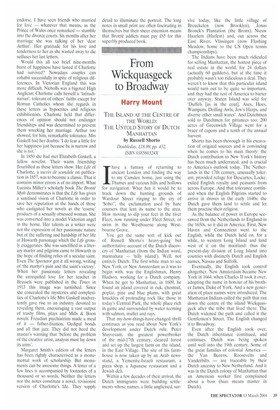From Wickquasgeck to Broadway
Harry Mount
THE ISLAND AT THE CENTRE OF THE WORLD: THE UNTOLD STORY OF DUTCH MANHATTAN by Russell Shorto Doubleday, £18.99, pp. 432, ISBN 038560324X Ihave a fantasy of returning to ancient London and finding the way to my Camden home, just using the Thames and various hills and hollows for navigation. What fun it would be to track down the hunting grounds of Wardour Street ringing to the cry of `Soho!', the exclamation used by hare coursers that lent its name to the area. How moving to dip your feet in the river Fleet, now running under Fleet Street, or swim in the Westbourne along Westbourne Grove.
You get the same sort of kick out of Russell Shorto's heavy-going but authoritative account of the Dutch discovery of Manhattan (from the Indian word, mannahata — 'hilly island'). Well, not entirely Dutch. The first white man to see New York, or New Amsterdam as it was to begin with, was the Englishman, Henry Hudson, working for a Dutch company. When he got to Manhattan, in 1609, he found an island covered in oak, chestnut, poplar, pine and blue plums, with great knuckles of protruding rock like those in today's Central Park, the whole place rich in game and surrounded by water teeming with salmon, mullet and rays.
That my-how-things-have-changed thrill continues as you read about New York's development under Dutch rule. Peter Stuyvesant, the greatest powerbroker of the mid-17th century, cleared forest and set up the largest farm on the island, in the East Village. The site of his farmhouse is now taken up by an Arab newsstand, a Yemenite-Israeli restaurant, a pizza shop, a Japanese restaurant and a Jewish deli.
Within a few decades of their arrival, the Dutch immigrants were building settlements whose names, a little anglicised, sur
vive today, like the little village of Breuckelen (now Brooklyn), Jonas Bronck's Plantation (the Bronx), Nieuw Haarlem (Harlem) and, out across the East River, Vlissingen (now Flushing Meadow, home to the US Open tennis championships).
The Indians have been much ridiculed for selling Manhattan, the hottest piece of real estate in the world, for 24 dollars (actually 60 guilders), but at the time it probably wasn't too ridiculous a deal. They weren't to know that this particular island would turn out to be quite so important, and they had the rest of America to barter over anyway. Staten Island was sold for 'Duffels [as in the coat], Axes, Hoes, Wampum, Drilling Awls, Jew's Harps, and diverse other small wares'. And Dutchmen sold to Dutchmen for pittances too: 200 acres of Greenwich Village went for a brace of capons and a tenth of the annual harvest, Shorto has been thorough in his excavation of original sources and is convincing when he comes to his main theory: the Dutch contribution to New York's history has been much underrated, and is crucial to America's outlook today. The Netherlands in the 17th century, unusually tolerant, provided refuge for Descartes, Locke, exiled English royalty and peasants from across Europe. And that tolerance continued when the English Pilgrims started to arrive in droves in the early 1640s: the Dutch gave them land to settle and let them practise their religion.
As the balance of power in Europe seesawed from the Netherlands to England in the 1650s, so it did in America. First, New Haven and Connecticut went to the English, while the Dutch held on, for a while, to western Long Island and land west of it on the mainland: thus the present-day division of Long Island into counties with distinctly Dutch and English names, Nassau and Suffolk.
Eventually, the English took control altogether. New Amsterdam became New York in 1664, when Charles II took it over, adopting the name in honour of his brother James, Duke of York. And a new generation of place names were introduced. The Manhattan Indians called the path that ran down the centre of the island Wickquasgeck after the tribe that lived there. The Dutch widened the path and called it the Gentlemen's Street. The English changed it to Broadway.
Even after the English took over, the Dutch inheritance continued, and continues, Dutch was being spoken until well into the 19th century. Some of the great families of colonial America — the Van Burens, Roosevelts and Vanderbilts — are traceable by their Dutch ancestry to New Netherland. And it was in the Dutch colony of Manhattan that an American worker first complained about a boss (baas means master in Dutch).


































































 Previous page
Previous page